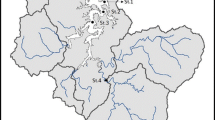Abstract
High turbid water in the river has been one of the major concerns to the downstream residence. During heavy local rainfall, high turbid water occurs in many countries located in the Asian monsoon climate region. The Andong and the Imha reservoir, two adjacent multipurpose dams, located in the upstream of the Nakdong River in Korea have suffered from severe turbid water problem. This study applied hydrodynamic water quality model CE-Qual-Riv1 to simulate turbidity propagation in downstream coupled with long-term watershed hydrologic model SWAT to consider contributions of tributaries. The outputs of runoff and suspended sediment in tributaries are incorporated into the input data necessary for the hydrodynamic water quality model. The simulation focused on the joint dam operation to minimize the negative impact of high turbid water in downstream river. Simulated turbidity in downstream shows a good agreement with the observed data, and the approach proposed in this study is applicable for establishing a sound turbid water management in downstream of the reservoir.








Similar content being viewed by others
References
Chaplot V (2005) Impact of DEM mesh size and soil map scale on SWAT runoff, sediment, and NO3–N loads predictions. J Hydrol 312:207–222
Chung SW, Lee HS (2009) Characterization and modeling of turbidity density plume induced into stratified reservoir by flood runoffs. Water Sci Technol 59(1):47–55
Chung SW, Ko IH, Kim YK (2008) Effect of reservoir flushing on downstream river water quality. J Environ Manage 86(1):139–147
Chung SW, Hipsey MR, Imberger J (2009) Modelling the propagation of turbid density inflows into a stratified lake: Daechung reservoir, Korea. Environ Model softw 24(12):1467–1482
Debele B, Srinivasan R, Parlange JY (2008) Coupling upland watershed and downstream waterbody hydrodynamic and water quality models (SWAT and CE-QUAL-W2) for better water resources management in complex river basins. Environ Model Asses 13(1):135–153
Di Luzio M, Arnold JG, Srinivasan R (2005) Effect of GIS data quality on small watershed stream flow and sediment simulations. Hydrol Process 19:620–650
Environmental Laboratory (1995) CE-QUAL-RIV1: A dynamic, one-dimensional (longitudinal) water quality model for streams user’s manual. US Army corps of engineer, Waterway experimental station, MS, USA
Kim JK, Son KH, Noh JW, Lee SU (2008) Estimation of the suspended sediment load in Imha–Andong watershed using SWAT model. J Korean Soc Environ Eng 30(12):1209–1217 (In Korean)
Lee SU, Kim JK, Noh JW, Ko IH (2007) Assessment of selective withdrawal facility in the Imha reservoir using CE-Qual-W2 model. J Korean Soc Water Qual 23(2):228–235 (In Korean)
Nash JE, Sutcliffe JV (1970) River flow forecasting through conceptual models, Part I-a discussion of principles. J Hydrol 10(3):282–290
Williams JR (1995) Chapter 25: The EPIC model. Computer models of watershed hydrology. Water Resources Publications, Highlands Ranch, pp 909–1000
Wischmeier WH, Smith DD (1965) Predicting rainfall–erosion losses from cropland east of the Rocky Mountains. Agriculture Handbook 282 USDA-ARS
Wischmeier WH, Smith DD (1978) Predicting rainfall erosion losses: a guide to conservation planning. Agricultural Handbook 282 USDA-ARS
Ye L, Yoon SW, Chung SW (2008) Application of SWAT for the estimation of soil loss in the Daechung dam basin. J Korea Water Res Assoc 41(2):149–162 (In Korean)
Yi HS, Jeong SA, Park SY, Lee YS (2008a) Modeling study of turbid water in the stratified reservoir using linkage of HSPF and CE-QUAL-W2. J Korean Soc Environ Eng 30(1):69–78 (In Korean)
Yi HS, Kim JK, Lee SU (2008b) Development of turbid water prediction model for the Imha dam watershed using HSPF. J Korean Soc Environ Eng 30(8):760–767 (In Korean)
Author information
Authors and Affiliations
Corresponding author
Rights and permissions
About this article
Cite this article
Noh, J., Kim, JC. & Park, J. Turbidity control in downstream of the reservoir: the Nakdong River in Korea. Environ Earth Sci 71, 1871–1880 (2014). https://doi.org/10.1007/s12665-013-2589-3
Received:
Accepted:
Published:
Issue Date:
DOI: https://doi.org/10.1007/s12665-013-2589-3




